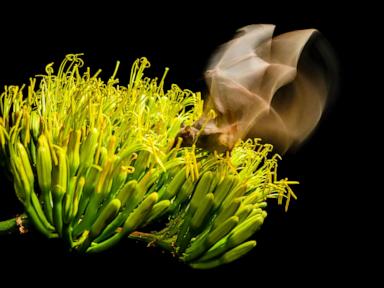Event JSON
{
"id": "599304b6e2c3b05a2811e51e99bef755513fedb1106531390ccdc26e93cbd912",
"pubkey": "7fd8226e08884a9329e406dba657699e12b638f116ab2e8d68efcba8b37e40d4",
"created_at": 1739174258,
"kind": 1,
"tags": [
[
"r",
"https://abcnews.go.com/US/wireStory/mexican-long-nosed-bats-strangers-southeastern-arizona-proof-118642469"
],
[
"subject",
"Mexican long-nosed bats are no strangers to southeastern Arizona. The proof is in the saliva"
],
[
"published_at",
"1739166638"
],
[
"image",
"https://s.abcnews.com/images/Weird/wirestory_e43c36080088ef0c189e900fd00f9acb_4x3_384.jpg"
],
[
"p",
"7fd8226e08884a9329e406dba657699e12b638f116ab2e8d68efcba8b37e40d4",
"wss://articles.layer3.news"
],
[
"imeta",
"url https://s.abcnews.com/images/Weird/wirestory_e43c36080088ef0c189e900fd00f9acb_4x3_384.jpg"
],
[
"t",
"mainstream:perspective"
],
[
"summary",
"Researchers from Bat Conservation International and Northern Arizona University used environmental DNA (eDNA) to confirm the presence of Mexican long-nosed bats in Arizona, which have been listed as endangered since 1988. The method involves collecting saliva samples from plants and hummingbird feeders along potential migration routes and comparing them to a database of DNA sequences. This non-invasive approach provides a new tool for wildlife managers to track the species and monitor their migration patterns."
]
],
"content": "nostr:nprofile1qyd8wumn8ghj7ctjw35kxmr9wvhxcctev4erxtnwv4mhxqpq0lvzymsg3p9fx20yqmd6v4mfncftvw83z64jartgal963vm7gr2qtk22d7\nhttps://s.abcnews.com/images/Weird/wirestory_e43c36080088ef0c189e900fd00f9acb_4x3_384.jpg\nArizona has added a new species of bat to the list of night-flying creatures that frequent the state\nhttps://abcnews.go.com/US/wireStory/mexican-long-nosed-bats-strangers-southeastern-arizona-proof-118642469",
"sig": "dec7dabb81907e975664216456909a0a3118b664b5d820cf9663935309174b4784dbc368d5bf06d90200ad9894790f54ee9972686479e3d138aa27ee307dd4b4"
}


